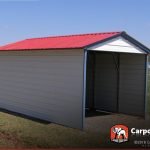You ache for some fresh air, but your home doesn’t have an outdoor space. You love to entertain guests, but you live in a small apartment. You want to enjoy the natural light during the day and watch the stars at night, but you live in a high-rise. This is where verandas come in handy.
Why You Should Add a Veranda to Your Home?
While verandas are primarily outdoor spaces, they can still be a perfect addition to your home. Here are the benefits of adding a veranda to your home:
Extra living space: We now have smaller living space than ever before, certain areas can be difficult to maximize. A veranda can provide you with an extra room that can be used for storage, relaxing, or entertaining guests.
Sunlight: When you can’t open your windows, you miss out on the sunlight that is key for your health and well-being. A veranda allows you to enjoy the sunlight and the fresh air, even if you live on the ground floor or in a high-rise apartment.
Privacy: If you have a small or busy street in front of your home or apartment, a veranda is the perfect way to have some privacy.
Outdoor living: Some people like to spend as much time as they can in nature, and a veranda is the perfect place to start. You can create an outdoor oasis right on your own property.
Ability to control the temperature: In the summer, you might want to keep the heat out. In the winter, you might want to keep the cold out. A veranda is the perfect solution.
Home value: There are many studies that prove that a house with a veranda can be worth more than a house without one.
What is a Veranda and What is its Purpose?
A veranda is an outdoor room with a roof that is open on one side, allowing for some exposure to the elements. Picture a porch that is partially open and you get the idea. Verandas are also known as sunrooms, conservatories, loggias, and balconies.
Sunrooms: Sunrooms are built to trap the sun’s rays and focus it on a specific area, such as plants or a seating area. They are primarily used for decoration and are not meant for regular use.
Conservatories: These are similar to sunrooms, but the focus is on growing plants rather than on decoration.
Loggias: A loggia is a large porch or veranda that is usually found along the second floor of a building.
Balconies: A balcony is open on two sides, while a veranda is open on one side.
Gazebos: A gazebo is a small, open-sided structure that is used as an observatory or rest area. It is usually located outside.
Types of Verandas You Can Include in Your Home
Corner verandas: The corners of your home are great for adding verandas. They don’t take up too much space and they can be used for seating areas.
Front verandas: If your home has a welcoming front entrance, it is a good place to add a veranda.
Overhanging verandas: If you have a low roof, you can add an overhanging veranda above it.
Room-in-the-garden verandas: If you love gardening, you can create a room-in-the-garden veranda right in the middle of your garden. It is perfect for storing pots, gardening tools, and furniture.
Side verandas: If your home has a larger side wall, you can add a side veranda that can be used as an extra room.
Conclusion
A veranda is the perfect solution for homes with limited outdoor space or indoor areas that can’t be opened to the outdoors. A veranda is the best way to enjoy the weather and sunlight, even if you live in a high-rise apartment or have a small outdoor space. You can choose from 6 different types of verandas and incorporate them into your home design effortlessly.









